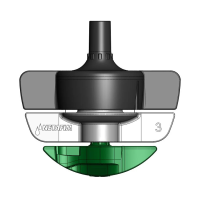8
UPSIDE-DOWN MICRO-EMITTERS HANDBOOK
MICRO-SPRINKLER/EMITTER SELECTION
Terms and concepts
To select the appropriate micro-sprinkler system, one must be familiar with the following terms and concepts:
A.
Precipitation rate (Pr)
B.
Water distribution uniformity
• Christiansen Coefficient of Uniformity (%CU)
• Distribution uniformity (%DU)
• Scheduling Coefficient (SC)
C.
Distribution pipe maximum length
D.
Head loss in micro-tube and accessories
E.
Micro-sprinkler/emitter water trajectory
A. Precipitation rate (Pr)
The average amount of water applied to the irrigated area during a specified period, measured in this
manual in mm/h (millimeters per hour) units.
Calculating Pr
Pr (mm/h) = Micro-sprinkler/emitter flow rate (l/h) / [Spacing between micro-sprinklers/emitters in the
same distribution pipe (m) x Spacing between distribution pipes (m)]
EXAMPLE
Where:
Micro-sprinkler/emitter flow rate 70 l/h
Spacing between micro-sprinklers/emitters on the same distribution pipes 2.0 m
Spacing between distribution pipes 2.5 m
70 / (2 x 2.5) = 14.0
Pr = 14.0 mm/h
Rooting
This is necessary when the farmer wants to increase growth by cutting. For this purpose, a moist air
volume is required. The plant should be grown in a humid environment to facilitate growth of the new
roots. The emitters chosen for this purpose must be able to increase humidity in a uniform manner.
For this purpose Netafim™ proposes the CoolNet Pro™ super-fine mister (see page 31).
Humidity increasing
In some cases, the farmer is required to increase the humidity in the structure (regardless of the two
actions mentioned above). For example, when planting/sowing new plants in a relatively cold period, to
perform this operation correctly, it is necessary to heat the air inside the structure. This will dry the air.
Therefore, to ensure the beginning of a proper and effective growth, moisture must be added to the air.
For this purpose, Netafim™ proposes the CoolNet Pro™ super-fine mister (see page 31).

